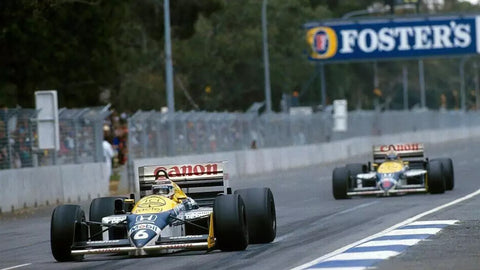 2021's Formula One season culminated in one of the greatest duels in any recent motorsport competition. The young, seemingly unstoppable, up-and-comer against the established, record-shattering veteran champion.
2021's Formula One season culminated in one of the greatest duels in any recent motorsport competition. The young, seemingly unstoppable, up-and-comer against the established, record-shattering veteran champion.
The nail-bitting season finale thrilled half of F1 fans and shocked the other half but had everyone on the edge of their seat.
But F1 is no stranger to epic rivalries. Here are three of its most famous.
Senna vs Prost

You'd be hard-pressed to imagine a more intense F1 rivalry than the one between Ayrton Senna and Alain Prost. Their head-to-head competition resulted in seven world titles in a nine-year span between 1985 and 1993. First as teammates at McLaren and again as adversaries after Prost moved to Ferrari.
Arguably, it all began in 1984 at the Monaco GP. In atrocious weather, the Brazilian rookie was storming in the uncompetitive Toleman. Quickly being caught, leader Prost waved frantically at the stewards to have the race red-flagged for unsafe conditions. The officials obliged, doing so just as Senna passed the slowing Prost as they crossed the finish line. He thought he’d won his first F1 race but hadn’t realised the results would be taken from the previous lap. As you can imagine, he was apoplectic.
Senna and Prost first became teammates at in 1988, and quickly developed a rivalry on track. In 1989, the two collided near the end of the penultimate round of the championship at Suzuka, ending Prost's race but allowing Senna to win. The nine points for victory would have kept the title fight alive, but the Brazilian was controversially disqualified for cutting the chicane, handing the championship to Prost.

A year later, Senna went into the penultimate race in Japan knowing that if Prost failed to finish, he would earn a second title. And so, at the first corner, he took the Frenchman out in a move that he confessed was deliberate a year later.
Prost’s fourth world title with Williams in 1993 saw the duo finish first and second in the drivers’ standings for a fifth and final time. Prost retired at the end of the season and, almost immediately, the animosity between him and Senna cleared. The two men became friends until Senna’s death at Imola in 1994.
Hunt vs Lauda

A rivalry so intense, it inspired one of the greatest racing films of all time. 'Rush' is an excellent movie, but if you were unfamiliar with the real-life drivers it was based on, you might come away thinking they were sworn enemies. In reality, they were good friends who got along well away from the track. They were even known to push each other to their limits during races.
In the 1976 championship, Hunt got off to a terrible start for McLaren, retiring from four of the first six races as Lauda won four and finished second twice. Hunt was initially disqualified after winning the Spanish GP but later got his victory reinstated.

It looked like the contest was over after a second victory at Paul Ricard was followed by disqualification at Brands Hatch. But then, a horrific crash at the Nurburgring left Lauda with permanent burns and badly damaged lungs. It seemed as though Hunt would have an easy task winning the championship, but Lauda came back six weeks later in his Ferrari. His return to racing took the championship down to the wire, and there was one more turn of events at the final race. The Austrian withdrew on the second lap because he thought the conditions were too dangerous. That left Hunt needing to finish fourth place or higher. In a frantic drive, he gained the positions he needed two laps from the finish. If you saw it in a movie, you'd think it was fake!
Mansell vs Piquet

In 1986, Nelson Piquet joined British driver Nigel Mansell at Williams as the team looked to improve upon its prior year's standings. With two of the best drivers on the grid, the team was primed for success. However, tensions began to mount between the two drivers. Williams took the Constructors' Championship in 1986, with Mansell and Piquet finishing second and third, respectively. Mansell was so close to taking the drivers' title, but an exploding tyre at the final race in Adelaide led to his retirement. He finished a mere two points behind Prost.
But the following year, both drivers desired more. Mansell won six races to Piquet’s three, and generated an iconic F1 moment. speeding down the Hangar Straight, Mansell sold Piquet an exquisite dummy. A slight turn left sent Piquet to defend, while Mansell veered right to the inside of the corner to take the lead. The home crowd erupted as Mansell was just one point behind leader Senna in the standings.

Although Mansell achieved the most victories, Piquet displayed greater consistency throughout the 1987 season. Piquet's eight additional podiums, seven of which were 2nd place finishes, positioned him to contend for the title of drivers' champion.
Piquet left Williams to join Lotus after the 1987 season. In contrast, Mansell's return to Williams the following year was marked with greater success. Mansell secured a second-place finish followed by his first World Championship win in 1992, more than ten years after his debut.



